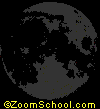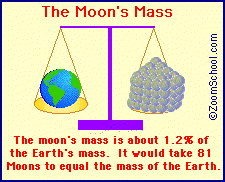|
Haha the moon never fails us too...the Arabic calendar is based on the moon...(hence they lose
1 year in every 30 years...sorry this is politically incorrect but the Gregorian Calendar and the Chinese Almanac are in fact
more accurate)
No night is romantic enough without the moon;
No sonata is ever complete without moonlight;
No werewolf can really exist without full moon;
Moonlight Shadows was my favourite song once...hehehe
And in the absence of the moon the nights will be pitch dark ...

Extracted from http://www.enchantedlearning.com/subjects/astronomy/moon/
 The moon is Earth's only natural satellite. The moon is a cold, dry orb whose surface is studded with craters and strewn with rocks and dust
(called regolith). The moon has no atmosphere. Recent lunar missions indicate that there might be some frozen ice at the poles. The moon is Earth's only natural satellite. The moon is a cold, dry orb whose surface is studded with craters and strewn with rocks and dust
(called regolith). The moon has no atmosphere. Recent lunar missions indicate that there might be some frozen ice at the poles.
 The same side of the moon always faces the Earth. The far side of the moon was first observed by humans in 1959 when the unmanned
Soviet Luna 3 mission orbited the moon and photographed it. Neil Armstrong and Buzz Aldrin (on NASA's Apollo 11 mission, which also included Michael Collins) were the first people to walk on the moon,
on July 20, 1969. The same side of the moon always faces the Earth. The far side of the moon was first observed by humans in 1959 when the unmanned
Soviet Luna 3 mission orbited the moon and photographed it. Neil Armstrong and Buzz Aldrin (on NASA's Apollo 11 mission, which also included Michael Collins) were the first people to walk on the moon,
on July 20, 1969.
 If you were standing on the moon, the sky would always appear dark, even during the daytime. Also, from any spot on the moon
(except on the far side of the moon where you cannot see the Earth), the Earth would always be in the same place in the sky; the phase of the Earth changes and the Earth rotates, displaying various continents. If you were standing on the moon, the sky would always appear dark, even during the daytime. Also, from any spot on the moon
(except on the far side of the moon where you cannot see the Earth), the Earth would always be in the same place in the sky; the phase of the Earth changes and the Earth rotates, displaying various continents.
THE MOON'S ORBIT
  The moon is about 238,900 miles (384,000 km) from Earth on average. At its closest approach (the lunar perigee) the moon is 221,460 miles (356,410 km) from the Earth. At its farthest approach (its apogee) the moon is 252,700 miles (406,700
km) from the Earth. The moon is about 238,900 miles (384,000 km) from Earth on average. At its closest approach (the lunar perigee) the moon is 221,460 miles (356,410 km) from the Earth. At its farthest approach (its apogee) the moon is 252,700 miles (406,700
km) from the Earth.
The moon revolves around the Earth in about one month (27 days 8 hours). It rotates around its
own axis in the same amount of time. The same side of the moon always faces the Earth; it is in a synchronous rotation with
the Earth.
 The Moon's orbit is expanding over time as it slows down (the Earth is also slowing down as it loses energy). For example,
a billion years ago, the Moon was much closer to the Earth (roughly 200,000 kilometers) and took only 20 days to orbit the
Earth. Also, one Earth 'day' was about 18 hours long (instead of our 24 hour day). The tides on Earth were also much stronger
since the moon was closer to the Earth. The Moon's orbit is expanding over time as it slows down (the Earth is also slowing down as it loses energy). For example,
a billion years ago, the Moon was much closer to the Earth (roughly 200,000 kilometers) and took only 20 days to orbit the
Earth. Also, one Earth 'day' was about 18 hours long (instead of our 24 hour day). The tides on Earth were also much stronger
since the moon was closer to the Earth.
SAROS
The saros is the roughly 18-year periodic cycle
of the Earth-Moon-Sun system. Every 6,585 days, the Earth, Moon and Sun are in exactly the same position. When there is a
lunar eclipse, there will also be one exactly 6,585 days later.
SIZE
 The moon's diameter is 2,140 miles (3,476 km), 27% of the diameter of the Earth (a bit over a quarter of the Earth's diameter). The moon's diameter is 2,140 miles (3,476 km), 27% of the diameter of the Earth (a bit over a quarter of the Earth's diameter).
The gravitational tidal influence of the Moon on the Earth is about twice as strong as the Sun's gravitational tidal influence. The Earth:moon size ratio is quite small in comparison to ratios of most other planet:moon
systems (for most planets in our Solar System, the moons are much smaller in comparison to the planet and have less of an
effect on the planet).
MASS AND GRAVITY
 The moon's mass is (7.35 x 10 22 kg), about 1/81 of the Earth's mass. The moon's mass is (7.35 x 10 22 kg), about 1/81 of the Earth's mass.
The moon's
gravitational force is only 17% of the Earth's gravity. For example, a 100 pound (45 kg) person would weigh only 17 pounds
(7.6 kg) on the Moon.
The moon's density is 3340 kg/m 3. This is about 3/5 the density
of the Earth.
 TEMPERATURE TEMPERATURE
The temperature on the Moon ranges from daytime highs of about 130°C = 265°F to nighttime lows of about
-110°C = -170°F
ATMOSPHERE
The moon has no atmosphere. On the moon, the sky is always appears
dark, even on the bright side (because there is no atmosphere). Also, since sound waves travel through air, the moon is silent;
there can be no sound transmission on the moon.


|

